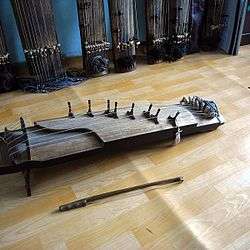Ajaeng
The ajaeng is a Korean string instrument. It is a wide zither with strings made of twisted silk, played by means of a slender stick made of forsythia wood, which is scraped against the strings in the manner of a bow. The original version of the instrument, and that used in court music (called the jeongak ajaeng), has seven strings, while the ajaeng used for sanjo and sinawi (called the sanjo ajaeng) has eight strings; some instruments may have up to nine, ten or twelve strings.
 | |
| Classification | |
|---|---|
| Related instruments | |
| |
| Ajaeng | |
| Hangul | |
|---|---|
| Hanja | |
| Revised Romanization | ajaeng |
| McCune–Reischauer | ajaeng |
The ajaeng is generally played while seated on the floor. It has a tone similar to that of a cello, but raspier. Some contemporary players prefer to use an actual horsehair bow rather than a stick, believing the sound to be smoother. The instrument is used in court, aristocratic, and folk music, as well as in contemporary classical music and film scores.
The ajaeng is derived from the Chinese yazheng (simplified: 轧筝; traditional: 軋箏) and Vietnamese nha tranh in Nhã nhạc - Vietnamese court music.
History
On the Korean Peninsula, Chinese music started to be imported from the late 7th century before and after the unification of the three kingdoms. During the Goryeo Dynasty, Song's court music was widely accepted.
In 1430, 'Uiryesangjeongso', the organization for the arrangement of court music and ceremonies arranged the institution of the Goryeo Dynasty and included Ajaeng to the instrument of Dangak. On the 'Five manners' in the annals of King Sejong, it describes the appearance of " Ajaeng. " The line was seven, and the left was broken, with catters placed on it. [1]
How to play
Instead of putting musical instruments on your lap, like a gayageum or a harpoon, you put on a pedestal called "Chosang" and hang the head of Ajaeng at an angle, and sit right with the bent tail on the floor. And makes a sound. The bark of the forsythia tree is peeled, and the surface is smoothed to make a ridge. Ribbon is used to paint the rosin because it reinforces the rubbing sound of string and string. Though the sound is rough because it makes a sound by rubbing a thick line with a forsythia tree instead of a horsehair, it is also a feature of Ajaeng. Nowadays, however, Sanjo Ajaeng is using a horsehooking band.[2] Sometimes, ajaeng can plucked like gayageum.
Video
- https://www.youtube.com/watch?v=ThdsRHnyf6c
- https://www.youtube.com/watch?v=yYbmaumqlWk
- https://www.youtube.com/watch?v=nqM2Qu-EEpY
- https://www.youtube.com/watch?v=SG1rgumf-w8
See also
- Yazheng
- Korean music
References
- "아쟁(Ajaeng)" (in Korean). Retrieved 2018-04-12.
- "Ajaeng". Archived from the original on 2018-04-14.